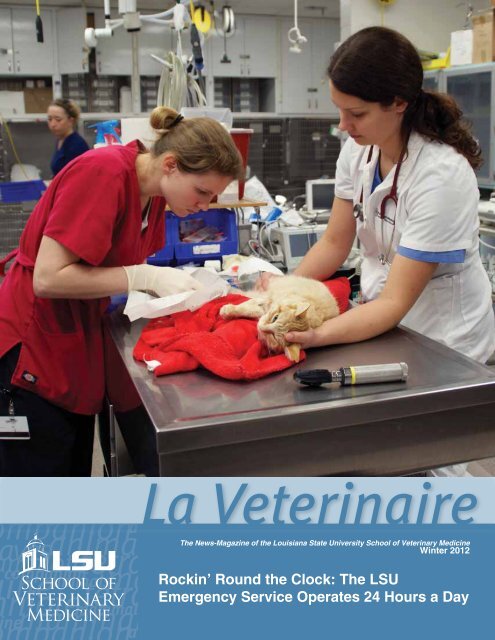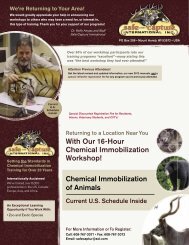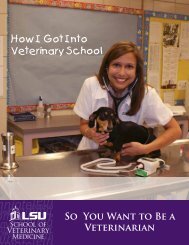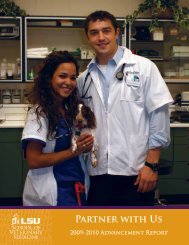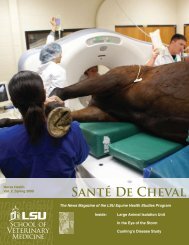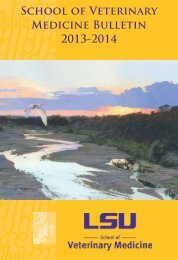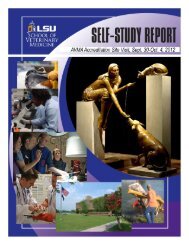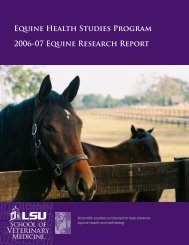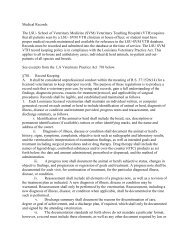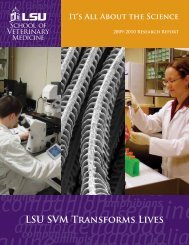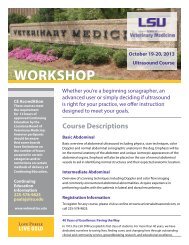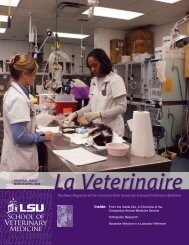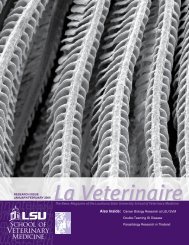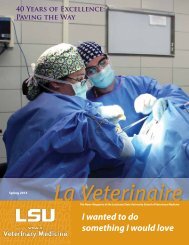Rockin' Round the Clock - School of Veterinary Medicine - Louisiana ...
Rockin' Round the Clock - School of Veterinary Medicine - Louisiana ...
Rockin' Round the Clock - School of Veterinary Medicine - Louisiana ...
Create successful ePaper yourself
Turn your PDF publications into a flip-book with our unique Google optimized e-Paper software.
The News-Magazine <strong>of</strong> <strong>the</strong> <strong>Louisiana</strong> State University <strong>School</strong> <strong>of</strong> <strong>Veterinary</strong> <strong>Medicine</strong><br />
Winter 2012<br />
Rockin’ <strong>Round</strong> <strong>the</strong> <strong>Clock</strong>: The LSU<br />
Emergency Service Operates 24 Hours a Day
LETTER FROM OUR DEAN<br />
In 2013, <strong>the</strong> LSU SVM will celebrate 40 years <strong>of</strong> veterinary<br />
medical education. In 1973, we accepted our first class <strong>of</strong><br />
36 students, all from <strong>Louisiana</strong>. Since <strong>the</strong>n, we have grown<br />
tremendously. We have graduated 2,492 veterinarians<br />
and over 364 MS and PhD students. We have moved from<br />
temporary housing on LSU’s main campus to our own<br />
building.<br />
The hospital that started out in temporary buildings adjacent<br />
to our current site is now a state-<strong>of</strong>-<strong>the</strong>-art medical facility<br />
housed within <strong>the</strong> LSU SVM building. Our hospital services<br />
have expanded since <strong>the</strong>n as well.<br />
While <strong>the</strong> hospital has always served our patients on a<br />
24-hour basis, we began accepting emergency cases at all<br />
hours approximately five years ago. We provide full-service<br />
emergency care for any patients that can get to us. This issue<br />
<strong>of</strong> La Veterinaire chronicles some <strong>of</strong> <strong>the</strong> cases admitted to our<br />
hospital for emergency care.<br />
Our hospital improvements also include a new dynamic<br />
endoscope to better diagnose our equine patients. You’ll learn<br />
about that in this issue as well. We also have several new<br />
faculty members who have joined <strong>the</strong> LSU SVM family.<br />
Our commitment is to our core mission: to save<br />
lives, find cures, and change lives every day. We<br />
will continue to provide <strong>the</strong> best education for our<br />
students, superior and compassionate care for our<br />
patients and ground-breaking research that improves<br />
<strong>the</strong> lives <strong>of</strong> both animals and people.<br />
Our research program continues to be a vibrant part <strong>of</strong> who<br />
we are and is supported by grants from both government and<br />
industry. The SVM held $46.8 million in extramural grants and<br />
contracts during 2010-11; our research partnerships provide<br />
us with <strong>the</strong> resources to investigate diseases that affect both<br />
animals and people.<br />
Peter F. Haynes, DVM, DACVS<br />
Dean<br />
LSU SCHOOL OF VETERINARY MEDICINE ADMINISTRATION<br />
Peter F. Haynes, DVM, MS, DACVS<br />
Dean<br />
James E. Miller, DVM, MPVM, PhD<br />
Interim Associate Dean for Research and Advanced Studies<br />
Joseph Taboada, DVM, DACVIM<br />
Associate Dean for Student and Academic Affairs<br />
David F. Senior, BVSc, DACVIM, DECVIM<br />
Associate Dean for Advancement and Strategic Initiatives<br />
Ernie Tanoos, MPA<br />
Assistant Dean for Finance and Administrative Services<br />
<strong>School</strong> <strong>of</strong> <strong>Veterinary</strong> <strong>Medicine</strong><br />
<strong>Louisiana</strong> State University<br />
Baton Rouge, <strong>Louisiana</strong> 70803<br />
Admissions (DVM Program) 225-578-9537<br />
Administration 225-578-9900<br />
Annual Giving & Alumni Affairs 225-578-9565<br />
Continuing Education 225-578-9825<br />
Public Relations 225-578-9922<br />
Small Animal Clinic 225-578-9600<br />
Large Animal Clinic 225-578-9500<br />
www.vetmed.lsu.edu
ON THE COVER<br />
Rockin’ <strong>Round</strong> <strong>the</strong> <strong>Clock</strong><br />
The LSU <strong>School</strong> <strong>of</strong> <strong>Veterinary</strong> <strong>Medicine</strong> <strong>Veterinary</strong> Teaching<br />
Hospital provides round-<strong>the</strong>-clock care for our patients seven<br />
days a week, 365 days a year. Learn about a typical weekend in<br />
<strong>the</strong> Small Animal Clinic. Full story, page 2.<br />
TABLE OF CONTENTS<br />
Rockin’ round <strong>the</strong> <strong>Clock</strong>................................................... 2<br />
Science + Industry = Medical Cures............................. 6<br />
Page 6<br />
Diagnosis in Motion............................................................. 8<br />
New Faculty...............................................................................10<br />
Student Spotlight.................................................................12<br />
Life at <strong>the</strong> LSU SVM................................................................14<br />
Saving Winter...........................................................................16<br />
MS/PhD Alumnus Pr<strong>of</strong>ile..................................................18<br />
DVM Alumnus Pr<strong>of</strong>ile..........................................................19<br />
Alumni Tracks & Baby Vets................................................20<br />
Page 14<br />
Page 8<br />
Page 19<br />
Giving & Advancement ......................................................22<br />
Upcoming Events....................................................................25<br />
COVER IMAGE<br />
<strong>Veterinary</strong> technician Ashley Wilson (left) and fourth-year<br />
veterinary student Randee Monceaux, prepare feline patient<br />
Minoux, to receive a blood transfusion in <strong>the</strong> Small Animal<br />
Intensive Care Unit at <strong>the</strong> LSU <strong>Veterinary</strong> Teaching Hospital.<br />
Page 16<br />
On http://www.facebook.com/, search for “LSU <strong>School</strong> <strong>of</strong> <strong>Veterinary</strong> <strong>Medicine</strong>” and<br />
become a fan. For Twitter, go to http://twitter.com/LSUVetMed and click “Follow.”<br />
Betty Karlsson, CFRE<br />
Executive Director <strong>of</strong> Advancement<br />
Ginger Guttner, MMC, APR<br />
Director <strong>of</strong> Public Relations<br />
Mission:<br />
The LSU <strong>School</strong> <strong>of</strong> <strong>Veterinary</strong> <strong>Medicine</strong> is a dynamic community dedicated to saving<br />
lives, finding cures, and changing lives through outstanding clinical and community<br />
service, educational excellence, and groundbreaking scholarly research.<br />
La Veterinaire is published by <strong>the</strong> <strong>Louisiana</strong> State University <strong>School</strong> <strong>of</strong> <strong>Veterinary</strong><br />
<strong>Medicine</strong>, Office <strong>of</strong> Public Relations. Communications should be addressed to <strong>the</strong><br />
Editor, La Veterinaire, <strong>School</strong> <strong>of</strong> <strong>Veterinary</strong> <strong>Medicine</strong>, <strong>Louisiana</strong> State University, Baton<br />
Rouge, LA 70803, or sent via e-mail to gguttner@vetmed.lsu.edu.
Rockin’ <strong>Round</strong> <strong>the</strong> <strong>Clock</strong><br />
At 6:30 p.m. on a Sunday, while you’re sitting down to a family dinner, veterinarians, technicians and students at <strong>the</strong><br />
LSU <strong>School</strong> <strong>of</strong> <strong>Veterinary</strong> <strong>Medicine</strong> <strong>Veterinary</strong> Teaching Hospital are taking care <strong>of</strong> patients. Some <strong>of</strong> <strong>the</strong>se patients<br />
were brought in during regular business hours, but o<strong>the</strong>rs have arrived after hours for emergency care. In 2011, over<br />
2,400 patients were admitted to <strong>the</strong> LSU Emergency Service (that’s an average <strong>of</strong> more than 200 per month). If your<br />
pet needs veterinary care after 5 p.m. or on a weekend, <strong>the</strong> LSU <strong>Veterinary</strong> Teaching Hospital is here for you.<br />
On a recent weekend in January, <strong>the</strong> Emergency Service saw 26 patients (11 on Saturday and 15 on Sunday). The veterinarians<br />
on duty work 12 hour shifts, <strong>the</strong> technicians are on for 10 hours, and <strong>the</strong> students are on for eight hours. Interns are assigned to<br />
<strong>the</strong> service to see emergencies during weekdays. They are assisted by veterinary students on <strong>the</strong> appropriate services, so if a<br />
patient comes in with a fracture, <strong>the</strong> orthopedic surgery service would lend a student.<br />
When small animal internal medicine resident Dr. Jocelyn Garber arrived for her shift at 8 a.m. on Sunday, she first checked on her<br />
Companion Animal <strong>Medicine</strong> Service patients from <strong>the</strong> previous week. Then she started seeing <strong>the</strong> emergency patients as <strong>the</strong>y<br />
arrived. In between caring for patients, Dr. Garber called owners and referring veterinarians to update <strong>the</strong>m on <strong>the</strong> status <strong>of</strong> her<br />
patients.<br />
One patient presented for emergency care on Sunday was Minoux, a 10-month-old female cat whose owners were<br />
referred to <strong>the</strong> LSU <strong>Veterinary</strong> Teaching Hospital by <strong>the</strong>ir veterinarian. On physical examination, Minoux’s mucous<br />
membranes appeared very pale, and a rapid blood test revealed pr<strong>of</strong>ound anemia with a packed cell volume <strong>of</strong> 6%<br />
(normal for cats is 28-50%). After blood was drawn for fur<strong>the</strong>r diagnostic tests and blood typing in preparation for a<br />
transfusion, Minoux was placed in an oxygen cage. Diagnostic possibilities included hemorrhage, a blood parasite, and<br />
bone marrow disease. Minoux became more energetic following <strong>the</strong> two-hour transfusion; however, test results indicated<br />
pancytopenia (reduced red cells, white cells and platelets), which subsequently turned out to be due to a bone marrow<br />
disease.<br />
2
From left, small animal medicine and surgery intern Dr. Jessica Leeman, veterinary student Alex David, veterinary<br />
technician Ashley Wilson (kneeling on floor), veterinary student Ho Cheol Shim and veterinary student Randee Monceaux<br />
work <strong>the</strong> Emergency Service at <strong>the</strong> LSU <strong>Veterinary</strong> Teaching Hospital on a Sunday night.<br />
Riley, a 3-year-old male Golden retriever, was brought in<br />
by his owners because he had vomited 15 times that day.<br />
<strong>Veterinary</strong> students Callie Habrun, Ho Cheol Shim and Alex<br />
David radiographed Riley’s abdomen to rule out intestinal<br />
obstruction or a foreign body. Although <strong>the</strong> radiographs<br />
revealed an enlarged spleen, no specific cause <strong>of</strong> vomiting<br />
was determined.<br />
Riley received supportive medication for nausea and some<br />
fluids to counter possible dehydration. After Riley was<br />
stabilized, he returned home with his owners later that<br />
evening with instructions to bring him back if he vomited any<br />
more that night.<br />
Avery, a female golden retriever-Chow mix, had been<br />
diagnosed with a urinary tract infection by her regular<br />
veterinarian earlier in <strong>the</strong> week. Her owners were concerned<br />
that her infection was getting worse, so <strong>the</strong>y brought her to<br />
<strong>the</strong> LSU <strong>Veterinary</strong> Teaching Hospital for evaluation.<br />
A urine sample was collected from Avery, and<br />
veterinary technician Claire Webster and veterinary<br />
student Alex David performed an ultrasound <strong>of</strong> her<br />
bladder. No abnormalities, such as bladder stones or cancer,<br />
were detected. Emergency duty intern Dr. Jessica Leeman<br />
submitted <strong>the</strong> urine sample to <strong>the</strong> Clinical Pathology service<br />
for a bacterial culture. Like Riley, Avery left with her owners to<br />
go home that night.<br />
On Monday morning, emergency duty interns Drs. Jessica<br />
Leeman, Sandra Tisdelle, and Benjamin Polansky met with<br />
Dr. Mark Acierno, associate pr<strong>of</strong>essor <strong>of</strong> companion animal<br />
medicine, to discuss <strong>the</strong> weekend’s patients. Following<br />
rounds, patients are transferred to <strong>the</strong> appropriate services<br />
(e.g., a patient with a fracture is transferred to <strong>the</strong> orthopedic<br />
surgery service, a patient with an abdominal mass goes to <strong>the</strong><br />
s<strong>of</strong>t tissue surgery service, etc.).<br />
3
Said Dr. Leeman, “I like having primary case responsibility,<br />
and I also like <strong>the</strong> fast-paced environment we have on <strong>the</strong><br />
emergency service.”<br />
“I was on <strong>the</strong> rotation for two weeks,” said Randee Monceaux,<br />
fourth-year veterinary student. “I liked that <strong>the</strong> patients were<br />
all different and all were a challenge. The hours were long,<br />
and some <strong>of</strong> our patients were so critical that even our best<br />
efforts were not enough, but I think <strong>the</strong> emergency rotation<br />
was helpful, and it will help me be more prepared to respond<br />
to critical patients when I’m a veterinarian.”<br />
Fourth-year veterinary student Alex David was assigned to<br />
<strong>the</strong> emergency service and also had several emergency<br />
shifts as part <strong>of</strong> her six-week surgery rotation and four-week<br />
medicine rotation. “I enjoyed not knowing what would come in<br />
next,” she said. “The emergency cases are more practical for<br />
<strong>the</strong> private practice setting, and <strong>the</strong>y gave me <strong>the</strong> opportunity<br />
to practice timely diagnosis and treatment. It was tough to<br />
work for most <strong>of</strong> <strong>the</strong> night and wake up early enough to take<br />
care <strong>of</strong> hospitalized patients before <strong>the</strong> start <strong>of</strong> <strong>the</strong> rotation<br />
<strong>the</strong> next morning, but I think that <strong>the</strong> emergency service is a<br />
beneficial rotation for all future veterinarians because most<br />
veterinarians will encounter emergency situations at some<br />
point in <strong>the</strong>ir career. The emergency rotation enabled me to<br />
practice assessing and triaging critical cases and to perform<br />
diagnostics in a timely manner.”<br />
Added Dr. Garber, “While it’s difficult to see a young animal<br />
that was previously fine but <strong>the</strong>n had some significant trauma,<br />
like a car accident, I like <strong>the</strong> cases that have something wrong<br />
that I can make better, particularly when <strong>the</strong>re is a good<br />
prognosis.”<br />
Clinical faculty in all specialty areas are available for back-up<br />
consultations as required after regular business hours.<br />
FROM TOP: Alex David, Ashley Wilson and Randee<br />
Monceaux prepare Minoux for a blood transfusion.<br />
Alex, Randee and Dr. Jessica Leeman ultrasound<br />
Avery’s bladder.<br />
Dr. Jocelyn Garber discusses Minoux’s status with her<br />
primary veterinarian.<br />
Dr. Leeman and Alex go over Avery’s status and<br />
discharge instructions with her owners.
If Your Pet Needs<br />
Emergency Care<br />
If your pet needs medical care at any time,<br />
call 225-578-9600. You can also bring<br />
your pet directly to <strong>the</strong> LSU <strong>Veterinary</strong><br />
Teaching Hospital.<br />
The Small Animal Clinic has doctors in <strong>the</strong><br />
hospital 24 hours a day.<br />
If Your Horse or Farm<br />
Animal Needs Emergency<br />
Care<br />
For emergency service for horses or farm<br />
animals, call 225-578-9500.<br />
The Large Animal Clinic has an on-call<br />
doctor who will come to <strong>the</strong> hospital as<br />
needed, so you should call ahead if you<br />
are bringing an emergency case afterhours<br />
to <strong>the</strong> Large Animal Clinic.<br />
FROM TOP: <strong>Veterinary</strong> student Ho Cheol Shim examines<br />
Riley.<br />
<strong>Veterinary</strong> students Alex David, Callie Habrun and Ho<br />
prepare Riley for radiographs <strong>of</strong> his abdomen.<br />
From left, Dr. Lorrie Gaschen, pr<strong>of</strong>essor <strong>of</strong> diagnostic<br />
imaging; Dr. Jessica Leeman; Dr. Alexandre Le Roux,<br />
diagnostic imaging resident; Dr. Mark Acierno; Dr.<br />
Sandra Tisdelle and Dr. Benjamin Polansky, both<br />
companion animal medicine and surgery interns.<br />
From left, emergency duty interns (from left) Dr. Sandra<br />
Tisdelle, Dr. Benjamin Polansky, and Dr. Jessica Leeman<br />
(right) discuss <strong>the</strong> weekend’s patients with Dr. Mark<br />
Acierno (center).<br />
5
Research<br />
Science<br />
+<br />
Industry<br />
= Medical<br />
Cures<br />
6<br />
Researchers at <strong>the</strong> LSU SVM <strong>of</strong>ten partner with<br />
industry in <strong>the</strong> search for new treatments for<br />
animal and human diseases. Frank Andrews,<br />
DVM, MS, DACVIM, pr<strong>of</strong>essor <strong>of</strong> veterinary<br />
medicine and director <strong>of</strong> <strong>the</strong> Equine Health Studies Program,<br />
brings experience and expertise to corporate/academic<br />
partnerships to develop new treatments for horses.<br />
In a recent study funded by Boehringer Ingelheim Vetmedica,<br />
Inc. (BVIM), Dr. Andrews participated in research to develop<br />
<strong>the</strong> drug pergolide to treat one <strong>of</strong> <strong>the</strong> most common conditions<br />
<strong>of</strong> horses older than 15 years, equine Cushing’s disease,<br />
o<strong>the</strong>rwise known as pituitary pars intermedia dysfunction<br />
(PPID).<br />
Horses with PPID exhibit hirsutism (long, curly hair coats that<br />
do not shed properly), increased water consumption, lethargy,<br />
muscle wasting, laminitis, and secondary infections, including<br />
sole abscesses, tooth root infections, and sinusitis.<br />
The pituitary gland, at <strong>the</strong> base <strong>of</strong> <strong>the</strong> brain, normally<br />
produces a wide array <strong>of</strong> important hormones that regulate<br />
organ functions. In PPID, <strong>the</strong> middle lobe <strong>of</strong> <strong>the</strong> pituitary<br />
gland (pars intermedia) becomes enlarged and overproduces<br />
cortisol. In healthy horses, cortisol production is inhibited by<br />
dopamine so that release <strong>of</strong> <strong>the</strong> hormone is tightly controlled.<br />
Horses with PPID do not seem to produce dopamine in<br />
adequate levels so that cortisol release continues unabated<br />
without regulation. In this sense, lack <strong>of</strong> dopamine production<br />
in PPID is analogous to <strong>the</strong> diminished dopamine availability<br />
observed in human Parkinson’s disease; however, because a<br />
different part <strong>of</strong> <strong>the</strong> brain is involved, <strong>the</strong> resulting disease is<br />
quite different.<br />
The clinical trial undertaken by Dr. Andrews in collaboration<br />
with researchers at Michigan State University and Oklahoma<br />
State University, in a multicenter effort, demonstrated that<br />
<strong>the</strong> clinical signs <strong>of</strong> PPID can be controlled by administration<br />
<strong>of</strong> pergolide, which apparently acts as a dopaminergic agent
substituting for dopamine and<br />
inhibiting excessive cortical<br />
production from <strong>the</strong> pars<br />
intermedia <strong>of</strong> <strong>the</strong> pituitary<br />
gland.<br />
Horses in <strong>the</strong> study showed<br />
improved hair coat, more<br />
complete and timely shedding,<br />
increased muscle mass, and<br />
a better mental attitude. In<br />
addition, <strong>the</strong>re was less risk<br />
<strong>of</strong> developing laminitis and<br />
infections, such as sinusitis,<br />
pneumonia, and tooth root<br />
abscesses.<br />
These studies resulted in<br />
pergolide being accepted<br />
as <strong>the</strong> first Food & Drug Administration-approved drug for<br />
treatment <strong>of</strong> PPID in horses. Dr. Andrews also assisted BVIM<br />
in developing a website to educate clients and veterinarians<br />
about PPID (http://www.prascend.com).<br />
Dr. Andrews has performed many studies on <strong>the</strong><br />
pathogenesis, treatment, and prevention <strong>of</strong> equine gastric<br />
ulcer syndrome (EGUS). The anatomy <strong>of</strong> <strong>the</strong> equine stomach<br />
makes it uniquely predisposed to <strong>the</strong> formation <strong>of</strong> mucosal<br />
ulcers, which leads to poor performance, colic (abdominal<br />
pain), roughened hair coat, lack <strong>of</strong> appetite, and weight loss,<br />
a real problem in both weanling and performance horses.<br />
Recently <strong>the</strong>re has been considerable interest in <strong>the</strong> use <strong>of</strong><br />
plants, herbs, minerals and natural agents <strong>of</strong>fered as feed<br />
supplements to prevent EGUS and gastric ulceration in<br />
humans.<br />
Using a model where he can assess <strong>the</strong> impact <strong>of</strong><br />
supplements on gastric mucosal integrity, Dr. Andrews<br />
is currently investigating <strong>the</strong> efficacy <strong>of</strong> several feed<br />
supplements to prevent EGUS, including an extract <strong>of</strong><br />
Seabuckthorn berries (Hippophae rhamnoides) b and a<br />
combination <strong>of</strong> performance minerals and a gut-conditioning<br />
agent. c Initial studies <strong>of</strong> this latter product appear promising<br />
for <strong>the</strong> prevention <strong>of</strong> EGUS after initial treatment.<br />
ABOVE: Dr. Frank Andrews in <strong>the</strong> Charles V. Cusimano<br />
Equine Physiology and Pharmacology Laboratory.<br />
OPPOSITE PAGE: Seabuckthorn berries.<br />
To better understand gastrointestinal function, Dr. Andrews<br />
has been using a wireless capsule d gastrointestinal monitoring<br />
system that measures pH, temperature, pressure, and transit<br />
time after it is swallowed. As <strong>the</strong> capsule passes through <strong>the</strong><br />
gastrointestinal tract, it transmits data to a monitor attached<br />
to <strong>the</strong> patient. This allows an accurate and non-invasive<br />
estimation <strong>of</strong> gastric emptying time (<strong>the</strong> time required for food<br />
to pass through <strong>the</strong> stomach) and transit time through <strong>the</strong> rest<br />
<strong>of</strong> <strong>the</strong> gastrointestinal tract. Dr. Andrews found that <strong>the</strong> adult<br />
horse empties <strong>the</strong> stomach in approximately eight hours and<br />
it takes about 48 hours for material to traverse <strong>the</strong> entire 140<br />
feet <strong>of</strong> a horse’s intestines. Dr. Andrews believes that such<br />
a non-invasive model will allow him to assess <strong>the</strong> impact <strong>of</strong><br />
medications on gastrointestinal function and assist in <strong>the</strong><br />
diagnosis <strong>of</strong> diseases <strong>of</strong> <strong>the</strong> stomach and intestines that alter<br />
motility, such as duodenal strictures (narrowing) and colic.<br />
“By building relationships with industry, academic research<br />
institutions, such as LSU, can put into practice and explore<br />
<strong>the</strong> feasibility <strong>of</strong> cutting-edge technology and innovative<br />
medicines to diagnose and treat diseases affecting horses<br />
and o<strong>the</strong>r animals,” said Dr. Andrews.<br />
a Prascend ® , Boehringer Ingelheim Vetmedica, Inc., St.<br />
Joseph, MO 64506.<br />
b SeaBuck TM Complete and SeaBuck TM GastroPlus,<br />
Seabuck, Equine LLC, Midvale, VT 84047.<br />
c Egusin ® , Centaur, Inc., Overland Park, KS, 66225.<br />
d SmartPill ® , SmartPill Corporation, Buffalo, NY 14203.<br />
7
Diagnosis in<br />
Motion<br />
The LSU SVM has a new tool to help diagnose<br />
upper respiratory problems in horses. Mick, a<br />
10-year-old Thoroughbred gelding, was examined<br />
using <strong>the</strong> dynamic endoscope (a video camera<br />
that is used internally). Lauren Brown <strong>of</strong> Baton Rouge, La.,<br />
Mick’s owner, said that Mick had left laryngeal hemiplegia<br />
(found on a prepurchase examination).<br />
Lauren said that <strong>the</strong> horse made a “roaring” noise when<br />
ridden, but he recently became exercise intolerant and was<br />
refusing jumps. Laura Riggs, DVM, PhD, DACVS, examined<br />
Mick and decided to use <strong>the</strong> dynamic endoscope to diagnose<br />
him because he was having trouble breathing. “Many upper<br />
airway diseases are dynamic in nature, meaning <strong>the</strong>y only<br />
occur when <strong>the</strong> horse is exercising,” said Dr. Riggs. “At rest,<br />
<strong>the</strong> airway may appear normal or not as severely affected.<br />
The dynamic scope was used to confirm <strong>the</strong> severity <strong>of</strong> <strong>the</strong><br />
known problem (laryngeal hemiplegia) and rule out any o<strong>the</strong>r<br />
secondary issues.”<br />
The dynamic endoscope is first secured to <strong>the</strong> noseband <strong>of</strong><br />
<strong>the</strong> bridle <strong>of</strong> <strong>the</strong> horse. It is attached to a battery pack and<br />
processor attached to a saddle pad worn by <strong>the</strong> horse. The<br />
fiber optic endoscope is <strong>the</strong>n placed in <strong>the</strong> pharynx. The<br />
image is recorded while <strong>the</strong> horse exercises and can be<br />
played back at normal or lower speed for evaluation.<br />
8
Clinical Case<br />
Said Dr. Riggs, “In this case, <strong>the</strong> horse was diagnosed with<br />
grade IV left laryngeal hemiplegia obstructing <strong>the</strong> airway when<br />
he was worked. No o<strong>the</strong>r abnormalities were noted.”<br />
The Optomed DRS endoscope system is installed in five<br />
steps. The first step is <strong>the</strong> installation <strong>of</strong> <strong>the</strong> endoscope into<br />
one <strong>of</strong> <strong>the</strong> horse’s nostrils. The second step requires <strong>the</strong><br />
endoscope to be attached to a special DRS bridle. In <strong>the</strong> third<br />
step, <strong>the</strong> processor is attached to <strong>the</strong> saddle pad, and in <strong>the</strong><br />
fourth step, <strong>the</strong> transmitter-recorder is also attached to <strong>the</strong><br />
saddle pad. For <strong>the</strong> last step, <strong>the</strong> examination <strong>of</strong> <strong>the</strong> upper<br />
respiratory tract is displayed on <strong>the</strong> receiver’s screen in real<br />
time. It takes about five minutes and two people to install.<br />
Mick underwent a pros<strong>the</strong>tic laryngoplasty (“tie-back”) and<br />
laser ventriculocordectomy (removal <strong>of</strong> <strong>the</strong> vocal cord and<br />
ventricle on <strong>the</strong> left side. For <strong>the</strong> tie-back procedure, an<br />
incision is made in <strong>the</strong> throat just behind <strong>the</strong> mandible. A<br />
heavy suture is placed between two areas <strong>of</strong> cartilage in <strong>the</strong><br />
larynx to mimic <strong>the</strong> non-functioning cricoarytenoideus dorsalis<br />
muscle (muscle <strong>of</strong> <strong>the</strong> larynx), which is responsible for holding<br />
<strong>the</strong> larynx open during breathing. This suture holds <strong>the</strong><br />
cartilage out <strong>of</strong> <strong>the</strong> airway and enables <strong>the</strong> horse to brea<strong>the</strong><br />
without obstruction or noise when it exercises.<br />
Mick has a good prognosis for return to jumping without<br />
exercise intolerance or noise. According to Lauren, he is<br />
currently exercising and doing great.<br />
IMAGES FROM TOP LEFT: Dr. Laura Riggs places <strong>the</strong><br />
endoscope on Mick. After <strong>the</strong> saddle is placed on Mick, <strong>the</strong><br />
camera is inserted into his airway via his nose. Dr. Colin<br />
Mitchell and veterinary student Emily Collins assist Dr. Riggs<br />
with <strong>the</strong> video monitor. <strong>Veterinary</strong> technician Nick McClure<br />
exercises Mick in order to examine his airway while he’s in<br />
motion. Dr. Riggs, interns, residents, and students observe<br />
Mick and <strong>the</strong> receiver screen.<br />
ABOVE: The top image shows a horse with a normal airway.<br />
The middle image shows Mick’s airway prior to treatment. The<br />
bottom image shows Mick at his first post-surgery event in<br />
February.<br />
9
New Faculty<br />
Fabio Del Piero,<br />
DVM, PhD,<br />
DACVP, tenured full<br />
pr<strong>of</strong>essor in Pathobiological<br />
Sciences, graduated from<br />
University <strong>of</strong> Milano, Italy, and<br />
obtained his American College<br />
<strong>of</strong> <strong>Veterinary</strong> Pathology (ACVP)<br />
specialty certification while at Cornell University, where<br />
he worked in pathology and virology. He obtained his<br />
PhD in <strong>the</strong> pathogenesis <strong>of</strong> zoonotic arboviruses in<br />
mammals and birds. Research activity includes <strong>the</strong><br />
study <strong>of</strong> <strong>the</strong> pathogenesis <strong>of</strong> infectious diseases and<br />
comparative pathology. He is an avid diagnostician with<br />
no species boundaries and is internationally renowned<br />
for his expertise in equine pathology. He received <strong>the</strong><br />
Ljudevit Jurak Award for his studies and teaching in<br />
<strong>the</strong> field <strong>of</strong> comparative pathology. He is a member <strong>of</strong><br />
<strong>the</strong> board <strong>of</strong> directors and vice-president senior <strong>of</strong> <strong>the</strong><br />
C.L. Davis foundation and a member <strong>of</strong> The British<br />
<strong>Veterinary</strong> Research Club. He has served on several<br />
ACVP committees and <strong>the</strong> editorial board, and he was<br />
<strong>the</strong> program chair <strong>of</strong> <strong>the</strong> 2009 ACVP meeting.<br />
Jon Fletcher,<br />
DVM, DACVIM,<br />
visiting assistant pr<strong>of</strong>essor <strong>of</strong><br />
companion animal medicine,<br />
received his DVM from <strong>the</strong> LSU<br />
SVM in 2005. He <strong>the</strong>n completed<br />
a small animal medicine and<br />
surgery rotating internship at<br />
Auburn University College <strong>of</strong> <strong>Veterinary</strong> <strong>Medicine</strong><br />
before returning to LSU SVM for his companion animal<br />
medicine residency, which he completed in 2008. He<br />
was most recently a staff internist at a private specialty<br />
hospital in south <strong>Louisiana</strong>. He is a Diplomate <strong>of</strong> <strong>the</strong><br />
American College <strong>of</strong> <strong>Veterinary</strong> Internal <strong>Medicine</strong>. His<br />
interests include endocrinology and <strong>the</strong> management <strong>of</strong><br />
auto-immune disease.<br />
Lisa “Abbi”<br />
Granger, DVM,<br />
DACVR, assistant pr<strong>of</strong>essor<br />
<strong>of</strong> diagnostic imaging in <strong>the</strong><br />
Department <strong>of</strong> <strong>Veterinary</strong> Clinical<br />
Sciences, received her BS from<br />
<strong>the</strong> University <strong>of</strong> Memphis in 2003<br />
and her DVM from <strong>the</strong> University <strong>of</strong><br />
Tennessee in 2007. She was most recently a radiology<br />
resident at Kansas State University. Dr. Granger is<br />
a Diplomate <strong>of</strong> <strong>the</strong> American College <strong>of</strong> <strong>Veterinary</strong><br />
Radiology.<br />
Martha A.<br />
Littlefield, DVM,<br />
MS, clinical assistant pr<strong>of</strong>essor in<br />
Comparative Biomedical Sciences,<br />
received her DVM in 1992 and her<br />
MS in 1994, both from <strong>the</strong> LSU<br />
SVM. She was a veterinarian at<br />
Perkins Road <strong>Veterinary</strong> Hospital from 1982-86 before<br />
becoming an instructor at <strong>the</strong> LSU SVM from 1986-2002.<br />
She <strong>the</strong>n served as assistant state veterinarian for <strong>the</strong><br />
<strong>Louisiana</strong> Department <strong>of</strong> Agriculture & Forestry through<br />
2010. She is <strong>the</strong> co-founder <strong>of</strong> <strong>the</strong> <strong>Louisiana</strong> State Animal<br />
Response Team and most recently served as director<br />
<strong>of</strong> <strong>the</strong> LDAF’s Feed, Fertilizer and Agricultural Liming<br />
Commission. She received <strong>the</strong> <strong>Louisiana</strong> <strong>Veterinary</strong><br />
Medical Association’s Veterinarian <strong>of</strong> <strong>the</strong> Year Award<br />
(2002) and <strong>the</strong> Everett D. Besch Distinguished Service<br />
Award (2009). She is interested in CNS endocrinology,<br />
stress in horses, hearing in cats, gross anatomy,<br />
histology, behavior, neuroanatomy, regulatory medicine,<br />
emergency preparedness, public<br />
health, and zoonotic diseases.<br />
Kenneth Pierce,<br />
DVM, DACVO, assistant<br />
pr<strong>of</strong>essor <strong>of</strong> ophthalmology in<br />
VCS, is a native New Orleanian.<br />
10
He received his BS from Tuskegee University in 2001<br />
and his DVM from <strong>the</strong> LSU SVM in 2005. In 2006, Dr.<br />
Pierce completed a Small Animal <strong>Medicine</strong> and Surgery<br />
internship at <strong>the</strong> University <strong>of</strong> Tennessee College <strong>of</strong><br />
<strong>Veterinary</strong> <strong>Medicine</strong>. In 2007, he traveled to sou<strong>the</strong>rn<br />
California to complete a specialty ophthalmology<br />
internship with Eye Care for Animals and B. Braun,<br />
Inc. He <strong>the</strong>n completed a four-year Comparative<br />
Ophthalmology residency at Michigan State University<br />
and MS degree in 2011. Dr. Pierce is a Diplomate <strong>of</strong><br />
<strong>the</strong> American College <strong>of</strong> <strong>Veterinary</strong> Ophthalmologists.<br />
His clinical interests are acute bullous keratopathy and<br />
progressive retinal atrophy. His research interests are<br />
heritable retinal diseases.<br />
Caryn Reynolds,<br />
DVM, DACVIM,<br />
assistant pr<strong>of</strong>essor <strong>of</strong> cardiology<br />
in VCS, received her BS from <strong>the</strong><br />
University <strong>of</strong> New Mexico in 1997<br />
and her DVM from Colorado State<br />
University in 2006. She completed<br />
her cardiology residency at <strong>the</strong><br />
University <strong>of</strong> Pennsylvania in 2011. She is a Diplomate<br />
<strong>of</strong> <strong>the</strong> American College <strong>of</strong> <strong>Veterinary</strong> Internal <strong>Medicine</strong><br />
(Cardiology). Her clinical interests are diagnosis and<br />
treatment <strong>of</strong> canine and feline heart disease and<br />
interventional cardiology. Her research interests are<br />
cardiac biomarkers, quality <strong>of</strong> life measures in dogs and<br />
cats with heart disease, and canine degenerative mitral<br />
valve disease.<br />
Duane<br />
Robinson, DVM,<br />
PhD, assistant pr<strong>of</strong>essor<br />
<strong>of</strong> companion animal surgery<br />
in VCS, was born in Guelph,<br />
Ontario, Canada. He received<br />
his DVM (with Honours) from <strong>the</strong><br />
Ontario <strong>Veterinary</strong> College at <strong>the</strong><br />
University <strong>of</strong> Guelph in 2000. Following graduation he<br />
spent a year in private small animal practice before<br />
returning to <strong>the</strong> Ontario <strong>Veterinary</strong> College for a rotating<br />
internship. The following year he was a surgical intern<br />
at Affiliated <strong>Veterinary</strong> Specialists in Orange Park/<br />
Jacksonville, Fla. He <strong>the</strong>n joined <strong>the</strong> Orthopedic<br />
Research Laboratory at Iowa State University. During this<br />
time, he also worked as an emergency and community<br />
practice clinician in <strong>the</strong> <strong>Veterinary</strong> Teaching Hospital at<br />
Iowa State. In 2006, he began a combined PhD/Small<br />
Animal Surgery Residency at <strong>the</strong> University <strong>of</strong> Minnesota,<br />
which he completed in 2011. Dr. Robinson’s research<br />
interests include orthopedic/implant-related infections,<br />
in particular <strong>the</strong> role <strong>of</strong> bacterial bi<strong>of</strong>ilms. Clinically, Dr.<br />
Robinson will be splitting his time between <strong>the</strong> orthopedic<br />
and s<strong>of</strong>t tissue services.<br />
Cathryn Stevens-<br />
Sparks, MS, instructor<br />
in <strong>the</strong> Department <strong>of</strong> Comparative<br />
Biomedical Sciences, received<br />
her MS from LSU in 1999 and is<br />
expected to receive her PhD from<br />
<strong>the</strong> LSU SVM in 2012. She has<br />
served as a teaching assistant<br />
in <strong>the</strong> Gross Anatomy Lab at <strong>the</strong> LSU SVM since<br />
2004. Dr. Sparks’s dissertation research focuses on<br />
veterinary anatomy and physiology with a special focus in<br />
neuroanatomy and neurophysiology.<br />
Julia Sumner,<br />
BVSc, DACVS, assistant<br />
pr<strong>of</strong>essor in companion animal<br />
surgery, received her BVSc from <strong>the</strong><br />
University <strong>of</strong> Sydney in Australia in<br />
2001. She spent several years in<br />
general companion animal practice<br />
before completing medicine and<br />
surgery internships both in Sydney<br />
and at Kansas State University. Dr.<br />
Sumner became a member <strong>of</strong> <strong>the</strong> Australian and New<br />
Zealand College <strong>of</strong> <strong>Veterinary</strong> Scientists (small animal<br />
surgery chapter) in 2003, and went on to complete a<br />
surgical residency at <strong>the</strong> University <strong>of</strong> Wisconsin in 2011.<br />
Dr. Sumner is a Diplomate <strong>of</strong> <strong>the</strong> American College <strong>of</strong><br />
<strong>Veterinary</strong> Surgeons. Her research interests include<br />
mechanisms <strong>of</strong> caudal cruciate ligament damage in<br />
dogs and treatment <strong>of</strong> urinary incontinence. At LSU, she<br />
divides her clinical time between orthopedics and s<strong>of</strong>t<br />
tissue surgery.<br />
11
Student Spotlight<br />
First-year veterinary<br />
students (from left)<br />
Bridger Smi<strong>the</strong>rs, Chris<br />
Rumore, Matt Greene and<br />
Mandy Seemann each<br />
has a parent who also<br />
attended <strong>the</strong> LSU SVM.<br />
In <strong>the</strong> Footsteps <strong>of</strong> <strong>the</strong>ir<br />
Mo<strong>the</strong>rs and Fa<strong>the</strong>rs<br />
Students in <strong>the</strong> Class <strong>of</strong> 2015 began <strong>the</strong>ir veterinary<br />
education at <strong>the</strong> LSU <strong>School</strong> <strong>of</strong> <strong>Veterinary</strong> <strong>Medicine</strong><br />
in August 2011. Five members <strong>of</strong> this class already<br />
have a special relationship with <strong>the</strong> LSU SVM—<strong>the</strong>y<br />
have a parent who also attended <strong>the</strong> LSU SVM.<br />
Amanda “Mandy” Seemann’s fa<strong>the</strong>r, Paul Seeman, Jr.,<br />
received his DVM in 1983. She is from Thibodaux, La., and<br />
she received her BS in Animal Sciences from LSU. Her fa<strong>the</strong>r<br />
co-owns a practice in Thibodaux with two o<strong>the</strong>r LSU SVM<br />
graduates—Dr. Dawn Koetting (LSU SVM 1984) and Dr.<br />
Natali Robichaux (LSU SVM 2000).<br />
Chris Rumore’s fa<strong>the</strong>r, James Rumore, Sr., received his DVM<br />
from <strong>the</strong> LSU SVM in 1981. Chris is from Rayne, La., and<br />
was an undergraduate at LSU. Dr. Rumore is a mixed animal<br />
12<br />
practitioner and Chris’s mo<strong>the</strong>r is an economics teacher at <strong>the</strong><br />
University <strong>of</strong> <strong>Louisiana</strong>-Lafayette.<br />
Bridger Smi<strong>the</strong>rs’s fa<strong>the</strong>r, Dr. Mark Smi<strong>the</strong>rs, received his<br />
DVM from <strong>the</strong> LSU SVM in 1984 and practices in Atlanta,<br />
Texas. Bridger is from Doddridge, Ark., and attended<br />
Texarkana-Texas A&M.<br />
Matt Greene’s fa<strong>the</strong>r, Dr. Gary M. Greene, received his DVM<br />
from <strong>the</strong> LSU SVM in 1982. His mo<strong>the</strong>r is also a veterinarian.<br />
Matt is from Covington, La., and attended LSU.<br />
Christian Lay’s fa<strong>the</strong>r, Dr. Blaine Firmin, received his DVM<br />
from <strong>the</strong> LSU SVM in 1994. Dr. Firmin owns a clinic in Slidell,<br />
La.
How old were you when you knew you wanted to be a<br />
veterinarian<br />
Mandy: I was probably about 5 or 6. It was about <strong>the</strong> time I got my first cat and was<br />
allowed to go on farm calls with my dad and watch him perform surgeries on dogs at<br />
his clinic.<br />
Chris: Quite some time now. While growing up, it was always interesting to watch<br />
my fa<strong>the</strong>r interact with his clients and patients. I can honestly say that he is a<br />
great role model and I want to be like him someday.<br />
Bridger: Very earliest was 7 years old. I actually intended on going to medical school<br />
and <strong>the</strong>n came back to <strong>the</strong> idea <strong>of</strong> vet medicine.<br />
Matt: I was 20.<br />
Class <strong>of</strong> 2015<br />
Applications Admitted<br />
<strong>Louisiana</strong> 135 61<br />
Arkansas 35 9<br />
O<strong>the</strong>r States 532 18<br />
Totals: 702 88<br />
Gender Make-up<br />
Male 22 (25.0%)<br />
Female 66 (75.0%)<br />
How many pets do you currently have<br />
Mandy: I have two pets. Sawyer is my 3-year-old male whippet, and Monkey is my<br />
4-year-old female domestic shorthair.<br />
Average Age: 23.9<br />
(range 19 to 50)<br />
Chris: Way too many to name. We own horses, dogs, cats, llamas, parrots, sheep,<br />
and goats. We also used to own camels and antelopes as well.<br />
Bridger: I have two cats, Ace and Pixel.<br />
Matt: I have a 2-year-old Brittany spaniel.<br />
What type <strong>of</strong> veterinary medicine are you most interested in<br />
Mandy: I am interested in everything from farm animal medicine to small animal<br />
critical care. I’d really like to get to know <strong>the</strong> full spectrum <strong>of</strong> veterinary medicine<br />
before I pick a specific concentration.<br />
Chris: Mixed practitioner (mostly horses, dogs, and cats).<br />
Bridger and Matt: Mixed animal.<br />
What do you hope to do following graduation<br />
Mandy: Following graduation, I would like to work in private practice and possibly own<br />
my own practice eventually.<br />
Chris: A lot <strong>of</strong> things can happen in <strong>the</strong> next four years, but hopefully I can work<br />
with my fa<strong>the</strong>r and build up knowledge and lessons that he would provide for me to<br />
become as successful as he is today.<br />
Bridger: I am not sure yet. Wherever <strong>the</strong> Lord leads me.<br />
Degrees Earned = 21<br />
BS 14<br />
BA 3<br />
AS 2<br />
Advanced Degree 2<br />
O<strong>the</strong>r 0<br />
No Degree 67<br />
GRE Average (verbal + quantitative)<br />
<strong>Louisiana</strong> 1144 (range 850 - 1390)<br />
Arkansas 1137 (range 930 - 1280)<br />
Out <strong>of</strong> State 1114 (range 620 - 1390)<br />
Entire Class 1137 (range 620 - 1390)<br />
Required Course GPA Average<br />
<strong>Louisiana</strong> 3.78 (range 3.36 - 4.00)<br />
Arkansas 3.70 (range 3.31 - 3.94)<br />
Out <strong>of</strong> State 3.83 (range 3.61 - 4.00)<br />
Entire Class 3.78 (range 3.31 - 4.00)<br />
Matt: I’d like to work in private practice.<br />
13
Life at <strong>the</strong> LSU SVM<br />
ABOVE: Attending <strong>the</strong> May 2011 Diploma Distribution Ceremony at <strong>the</strong><br />
LSU SVM are (from left) Dr. Stephen Gaunt (LSU SVM 1977), pr<strong>of</strong>essor; Dr.<br />
Joseph Francis, associate pr<strong>of</strong>essor; Dr. Carrie Elks, PhD recipient; Dr.<br />
Kevin Macaluso, associate pr<strong>of</strong>essor; Dr. Piyanate Sunyakumthorn, PhD<br />
recipient; Dr. Peter Haynes, dean; Dr. James Miller, interim associate dean<br />
for research and advanced studies; and Dr. Christopher Mores, associate<br />
pr<strong>of</strong>essor.<br />
ABOVE: Aviane Aguillard (Class <strong>of</strong> 2015) receives her blue<br />
coat from Dr. Joseph Smith (LSU SVM 1989) at <strong>the</strong> August<br />
2011 Year I Coating Ceremony. Dr. Smith is president <strong>of</strong> <strong>the</strong><br />
<strong>Louisiana</strong> <strong>Veterinary</strong> Medical Association, which sponsors<br />
<strong>the</strong> ceremony along with <strong>the</strong> Arkansas <strong>Veterinary</strong> Medical<br />
Association and Hill’s Pet Nutrition.<br />
ABOVE: Members <strong>of</strong> <strong>the</strong> Class <strong>of</strong> 2015 participate<br />
in <strong>the</strong> Freshman Leadership Experience in August<br />
2011 so <strong>the</strong>y can get to know each o<strong>the</strong>r and some<br />
<strong>of</strong> <strong>the</strong> faculty and staff before orientation and<br />
classes begin.<br />
RIGHT: <strong>Veterinary</strong> students compete in <strong>the</strong><br />
volleyball tournament at <strong>the</strong> annual Fall Family<br />
Picnic in October 2011.<br />
14
LEFT: Erika Fauth (Class <strong>of</strong> 2013) presents her poster at <strong>the</strong><br />
annual Phi Zeta Research Emphasis Day in September 2011.<br />
Pictured with her are Dr. Mark Acierno, associate pr<strong>of</strong>essor<br />
<strong>of</strong> companion animal medicine, and Dr. Carley Saelinger,<br />
cardiology resident.<br />
BELOW: Attending <strong>the</strong> Diploma Distribution Ceremony at <strong>the</strong><br />
LSU SVM in December 2011 are (from left) Dr. Stephen Gaunt<br />
(LSU SVM 1977), pr<strong>of</strong>essor <strong>of</strong> veterinary clinical pathology;<br />
Dr. Petrisor Baia, MS recipient; Saybl Sprinkle, MS recipient in<br />
August 2011; Dr. Laura Riggs, assistant pr<strong>of</strong>essor <strong>of</strong> equine<br />
surgery; Dr. Wes Baumgartner, PhD recipient; Dr. Ronald<br />
Thune, head <strong>of</strong> <strong>the</strong> Pathobiological Sciences department;<br />
and Dr. James Miller, interim associate dean for research and<br />
advanced studies.<br />
ABOVE: <strong>Veterinary</strong> students demonstrate to visitors at <strong>the</strong><br />
30th Annual Open House on February 11 how <strong>the</strong> equine<br />
treadmill is used in research.<br />
RIGHT: Third-year veterinary student Carolyn Wong<br />
explains how anes<strong>the</strong>sia is used in <strong>the</strong> <strong>Veterinary</strong> Teaching<br />
Hospital to Open House visitors. Over 4,700 people visited<br />
<strong>the</strong> LSU SVM for <strong>the</strong> 2012 Open House.<br />
15
Saving Winter<br />
LSU <strong>Veterinary</strong> <strong>School</strong> Alumnus Helps Rescue Dolphin<br />
In December 2005 a 3-month-old bottlenose dolphin<br />
became trapped in a crab trap line near Cape<br />
Canaveral, Fla., in <strong>the</strong> Indian River Lagoon. The story<br />
<strong>of</strong> <strong>the</strong> baby dolphin’s rescue and rehabilitation is <strong>the</strong><br />
basis <strong>of</strong> <strong>the</strong> Warner Bro<strong>the</strong>rs movie, “Dolphin Tale.”<br />
“Her mo<strong>the</strong>r had likely learned to scavenge <strong>the</strong> bait from<br />
crab traps and as <strong>the</strong> baby dolphin lingered above on <strong>the</strong><br />
water’s surface she became entrapped in <strong>the</strong> float line,” said<br />
Dr. David Kilpatrick (LSU SVM 1988). What happened to <strong>the</strong><br />
baby dolphin’s mo<strong>the</strong>r is unknown; when rescuers came to<br />
<strong>the</strong> scene she was nowhere to be found and never appeared<br />
prior to retrieving <strong>the</strong> baby from <strong>the</strong> lagoon for transport. The<br />
baby dolphin would come to be known as “Winter” because<br />
she was found on a cold winter day.<br />
<strong>the</strong>y carefully disentangled<br />
Winter from <strong>the</strong> crab trap<br />
lines. After assessing Winter’s<br />
injuries, <strong>the</strong> team began<br />
looking for facilities that are<br />
permitted to provide care for<br />
protected marine mammals<br />
in Florida. Dr. Kilpatrick said,<br />
“Clearwater Aquarium in<br />
Clearwater, Fla., was able to accommodate her, so we began<br />
<strong>the</strong> slow drive across <strong>the</strong> state in a specially-fitted truck for<br />
transporting injured marine mammals. Winter remained stable<br />
during <strong>the</strong> trip, and we arrived in Clearwater near midnight.<br />
She was placed in a special pool and provided with constant<br />
attention as she was far too weak to swim unattended.”<br />
Winter was originally sighted by a fisherman, who contacted<br />
local authorities. She was rescued by a team <strong>of</strong> marine<br />
mammal stranding responders from Harbor Branch<br />
Oceanographic Institute and Hubbs-Seaworld Research<br />
Institute; Dr. David Kilpatrick (LSU SVM 1988) was <strong>the</strong><br />
veterinarian on <strong>the</strong> team. Arriving on <strong>the</strong> scene in an<br />
undeveloped area <strong>of</strong>f <strong>the</strong> barrier island on <strong>the</strong> Indian River,<br />
“In my original examination <strong>of</strong> Winter, it was apparent that<br />
<strong>the</strong> rope entrapment <strong>of</strong> her peduncle [tail] and fluke [tail<br />
flipper] had severely compromised <strong>the</strong> blood supply to <strong>the</strong><br />
area, raising <strong>the</strong> high probability that necrosis [tissue death]<br />
and loss <strong>of</strong> <strong>the</strong> tail fluke were likely,” he added. Euthanasia<br />
is a serious consideration in <strong>the</strong>se cases, as injuries to wild<br />
dolphins <strong>of</strong>ten require long-term care in rehabilitation facilities,<br />
16
and <strong>the</strong> acclimatization to human care and feeding <strong>of</strong>ten<br />
makes return to <strong>the</strong>ir wild environment impossible.<br />
“Winter was calm and relaxed when handled and examined<br />
in <strong>the</strong> water,” said Dr. Kilpatrick. “Although I knew retrieving<br />
her from <strong>the</strong> lagoon and placing her in a captive environment<br />
would likely preclude her ever returning to her native life in<br />
<strong>the</strong> wild, Winter had unintentionally become an orphan and<br />
was completely helpless as a direct result <strong>of</strong> human activities.<br />
In a sense, we owed it to Winter to restore her life as best as<br />
possible, and <strong>the</strong> many unknowns <strong>of</strong> her future would have to<br />
be addressed as <strong>the</strong>y became manifest.”<br />
The rescue and transport <strong>of</strong> Winter to <strong>the</strong> Clearwater<br />
Aquarium was <strong>the</strong> first step in a long and extensive effort to<br />
save her life. Despite round-<strong>the</strong>-clock care, <strong>the</strong> tail fluke and<br />
last two vertebrae deteriorated and eventually separated<br />
from <strong>the</strong> tail. She was unable to propel herself through <strong>the</strong><br />
water with up-and-down motion <strong>of</strong> <strong>the</strong> tail. She moved herself<br />
through <strong>the</strong> water by swinging <strong>the</strong> tail laterally back and<br />
forth like a fish and, although this was effective, a potentially<br />
life-threatening complication <strong>of</strong> this activity in a growing<br />
dolphin is scoliosis. After many arduous trials and failures,<br />
<strong>the</strong> dedicated efforts <strong>of</strong> <strong>the</strong> staff at Clearwater Aquarium<br />
and Hangar Pros<strong>the</strong>tics and Orthotics, Inc. were eventually<br />
able to develop a tail-fluke pros<strong>the</strong>sis for Winter that would<br />
both adhere to her body without irritation and withstand <strong>the</strong><br />
incredible forces <strong>of</strong> propelling a 400-pound dolphin through<br />
<strong>the</strong> water.<br />
“Although <strong>the</strong>re were a few consultations regarding Winter’s<br />
care during <strong>the</strong> first few weeks, <strong>the</strong> remainder <strong>of</strong> her longterm<br />
rehabilitation and recovery were <strong>the</strong> result <strong>of</strong> <strong>the</strong><br />
remarkable volunteers and staff at Clearwater Aquarium and<br />
Hanger Pros<strong>the</strong>tics and Orthotics. After Winter’s tail fluke<br />
was lost to disease, intensive efforts were made to devise a<br />
pros<strong>the</strong>sis that Winter would tolerate, could withstand long<br />
immersion in saltwater, and was <strong>of</strong> great overall durability.<br />
This process was time-consuming and fraught with many<br />
failures and required <strong>the</strong> determined, donated efforts <strong>of</strong><br />
Hanger Pros<strong>the</strong>tics and Orthotics over a sustained period<br />
<strong>of</strong> time. In solving Winter’s pros<strong>the</strong>tic needs, new insights<br />
were gained in <strong>the</strong> field <strong>of</strong> human pros<strong>the</strong>tics. Along <strong>the</strong> way,<br />
Winter has become a source <strong>of</strong> inspiration for individuals with<br />
disabilities <strong>of</strong> all ages and <strong>the</strong> public at large. In giving Winter<br />
<strong>the</strong> benefit <strong>of</strong> <strong>the</strong> doubt, we have helped not only her but<br />
ourselves.”<br />
Dr. Kilpatrick received his DVM from LSU in 1988. He is <strong>the</strong><br />
owner and a practicing veterinarian at Southside <strong>Veterinary</strong><br />
Hospital in Vero Beach, Fla., and an Institutional Animal Care<br />
and Use Committee veterinarian at Torrey Pines Institute for<br />
Molecular Studies in Ft. Pierce, Fla. He sees wildlife cases<br />
weekly and has periodically assisted with marine mammal<br />
strandings and care for 14 years. You can see videotape<br />
footage <strong>of</strong> him and many <strong>of</strong> <strong>the</strong> marine mammal rescuers and<br />
rehabilitators during <strong>the</strong> actual rescue and rehabilitation <strong>of</strong><br />
Winter at <strong>the</strong> end <strong>of</strong> “Dolphin Tale.”<br />
Image: Poster for <strong>the</strong> movie,<br />
“Dolphin Tale.”<br />
Photo: Winter swimming at <strong>the</strong><br />
Clearwater Aquarium in Clearwater,<br />
Fla. Photo provided courtesy <strong>of</strong> <strong>the</strong><br />
Clearwater Aquarium.<br />
Photo: Dr. David Kilpatrick (center)<br />
discusses <strong>the</strong> rescue <strong>of</strong> a pygmy<br />
sperm whale to rescuers and EMS<br />
responders in Ft. Pierce, Fla.<br />
17
MS/PhD Alumnus Pr<strong>of</strong>ile<br />
Gleeson Murphy,<br />
DVM, PhD<br />
MAJ, VC, USA<br />
Chief, Preventive <strong>Medicine</strong> and<br />
<strong>Veterinary</strong> Services<br />
Eskan Village <strong>Veterinary</strong> Treatment<br />
Facility<br />
Saudi Arabia<br />
What made you want to be a research scientist<br />
Yes, I was a “pr<strong>of</strong>essional student;” and that was because I<br />
truly enjoyed <strong>the</strong> academic setting. In a hopeful effort to bolster<br />
my opportunities for a future career in academia, I took a<br />
chance on entering <strong>the</strong> DVM/PhD program at LSU. My thought<br />
was that a solid foundation in animal medicine would be <strong>the</strong><br />
ideal platform for conducting ethical and meaningful biomedical<br />
research in an academic, government, or industrial laboratory.<br />
What is your current title and place <strong>of</strong><br />
employment<br />
Currently, I am <strong>the</strong> Chief <strong>of</strong> Preventive <strong>Medicine</strong> and <strong>Veterinary</strong><br />
Services for <strong>the</strong> US Military Training Mission (USMTM) to <strong>the</strong><br />
Kingdom <strong>of</strong> Saudi Arabia. I also provide preventive medicine<br />
and veterinary services to all <strong>of</strong> <strong>the</strong> o<strong>the</strong>r US entities within <strong>the</strong><br />
Kingdom, including <strong>the</strong> US Embassy – Riyadh, <strong>the</strong> Office <strong>of</strong><br />
<strong>the</strong> Program Manager – Saudi Arabian National Guard (OPM-<br />
SANG) Modernization Program, <strong>the</strong> Office <strong>of</strong> <strong>the</strong> Program<br />
Manager - Facilities Security Forces (OPM-FSF), and <strong>the</strong> 64th<br />
Air Expeditionary Wing (military working dog support). This<br />
will be a two-year tour in <strong>the</strong> Kingdom. While not a researchoriented<br />
assignment, it is an assignment required to broaden<br />
my experiences with <strong>the</strong> Army <strong>Veterinary</strong> Corps mission.<br />
What is your primary area <strong>of</strong> research<br />
My previous assignment was four years at <strong>the</strong> US Army<br />
Medical Research Institute <strong>of</strong> Chemical Defense (USAMRICD)<br />
where I was Chief <strong>of</strong> <strong>the</strong> Medical Toxicology Branch. There,<br />
I was charged with supervising and managing a group <strong>of</strong><br />
five civilian scientists, <strong>the</strong>ir research programs, and <strong>the</strong>ir<br />
technical support teams. My own research project was aimed<br />
at characterizing <strong>the</strong> “moment <strong>of</strong> exposure” respiratory<br />
physiological effects <strong>of</strong> nerve gas inhalation with and without<br />
<strong>the</strong> use <strong>of</strong> bronchodilator-steroid combination <strong>the</strong>rapy. This<br />
project is ongoing even while I am stationed in Saudi Arabia.<br />
How did <strong>the</strong> LSU SVM prepare you for your<br />
career<br />
The availability <strong>of</strong> <strong>the</strong> DVM/PhD program at <strong>the</strong> LSU SVM was<br />
great for me. The fast pace and challenging administrative<br />
navigation <strong>of</strong> <strong>the</strong> program made <strong>the</strong> subsequent transition to<br />
military/government life a breeze. I also was fortunate that my<br />
first military assignment was at a government research lab<br />
whose focus was respiratory toxicology.<br />
What are some <strong>of</strong> your most memorable<br />
moments from LSU<br />
LSU football! Even though <strong>the</strong>re was a bit <strong>of</strong> a bowl-drought<br />
during my years in <strong>the</strong> Tiger Band (1997-1999), tailgating<br />
during vet school was a BLAST!<br />
Graduation–A bittersweet moment that signified <strong>the</strong> end <strong>of</strong> <strong>the</strong><br />
10 best years <strong>of</strong> my life (so far). Yes, it took 10 years to get<br />
three degrees.<br />
I’d like to acknowledge four people who took a chance on me:<br />
my fantastic and (relatively) patient mentors, Dr. Arthur Penn<br />
and my Graduate Committee, Drs. Steven Barker, William<br />
Henk, and Dan Paulsen).<br />
18
DVM Alumnus Pr<strong>of</strong>ile<br />
Sarah Oulet (left) and Morgan McClendon are<br />
photographed with Dr. Alleman following an event at UF.<br />
Dr. Alleman served as adviser to both Sarah and Morgan.<br />
What made you want to be a veterinarian<br />
At first, I was impressed with a local veterinarian who let me<br />
observe a surgical procedure on my own pet, and, at first, I<br />
wanted to become a veterinarian so that I could do surgery<br />
on pets. That did not pan out. Now, in <strong>the</strong> later stages <strong>of</strong> my<br />
career I see that veterinary medicine is an exciting and broad<br />
field <strong>of</strong> medicine that provides tremendous opportunities that<br />
reach many aspects <strong>of</strong> animal and human health.<br />
How did <strong>the</strong> LSU SVM prepare you for your<br />
career<br />
I had excellent instructors all throughout veterinary school,<br />
many <strong>of</strong> whom inspired me and helped me after graduation<br />
with advice and recommendations that helped to shape my<br />
career.<br />
What was <strong>the</strong> LSU SVM like when you<br />
attended<br />
It was new and exciting. It was a young school with a high<br />
level <strong>of</strong> enthusiasm with students, staff and faculty. There was<br />
<strong>the</strong> excitement <strong>of</strong> being in <strong>the</strong> first full class <strong>of</strong> 80 students,<br />
<strong>the</strong> move from <strong>the</strong> on-campus halls to <strong>the</strong> new building and<br />
hospital, and easy parking! I became very close to many <strong>of</strong> my<br />
classmates and faculty. It was like having an extended family.<br />
Rick Alleman, DVM,<br />
PhD, ABVP, ACVP<br />
Pr<strong>of</strong>essor and Service Chief <strong>of</strong> Clinical<br />
Pathology and Director <strong>of</strong> Laboratories<br />
University <strong>of</strong> Florida College <strong>of</strong><br />
<strong>Veterinary</strong> <strong>Medicine</strong><br />
Recipient <strong>of</strong> <strong>the</strong> 2011 LSU SVM<br />
Distinguished Alumnus Award<br />
What does <strong>the</strong> LSU SVM mean to you<br />
LSU provided <strong>the</strong> foundation <strong>of</strong> my career. I am very proud to<br />
be a Tiger and I am always honored to be introduced as an<br />
LSU Graduate from <strong>the</strong> Class <strong>of</strong> 1980.<br />
What is a memorable moment from your time as<br />
a student at <strong>the</strong> LSU SVM<br />
There are so many it is hard to pick one. I love <strong>the</strong> humorous<br />
moments, so I will pick <strong>the</strong> time that Ralph Abraham was<br />
taking notes for <strong>the</strong> class but was going to be absent for a<br />
lecture. He asked me to take notes that day and I did. Ralph<br />
had an amusing habit <strong>of</strong> kind <strong>of</strong> scratching his front teeth if he<br />
was really concentrating on a lecture. I would tease him about<br />
that asking if his incisors itched. So, when taking notes for<br />
<strong>the</strong> class, I added a small comment that indicated one <strong>of</strong> <strong>the</strong><br />
clinical signs associated with Erysipelothrix infection in pigs<br />
is that it causes <strong>the</strong>ir teeth to itch. It was incorporated into <strong>the</strong><br />
notes and printed out. A few weeks later, when it was time to<br />
study for <strong>the</strong> test, Ralph was studying and found <strong>the</strong> comment.<br />
He <strong>the</strong>n had to get up in front <strong>of</strong> <strong>the</strong> class and explain that it<br />
was an error. Pigs really did not have itchy teeth.<br />
At <strong>the</strong> University <strong>of</strong> Florida, Rick has received <strong>the</strong> Teacher <strong>of</strong><br />
<strong>the</strong> Year Award (2002 and 2008), <strong>the</strong> Distinguished Teacher<br />
Award (2002), <strong>the</strong> Support Service Clinician <strong>of</strong> <strong>the</strong> Year Award<br />
(2004, 2005, 2006, 2007), <strong>the</strong> Clinical Sciences Teacher <strong>of</strong><br />
<strong>the</strong> Year Award (2009), and <strong>the</strong> UF Research Foundation<br />
Pr<strong>of</strong>essorship Award (2010). Dr. Alleman also gave <strong>the</strong><br />
commencement address at <strong>the</strong> UF CVM in 2003 and 2011.<br />
19
Alumni Tracks & Baby Vets<br />
1980<br />
Dr. William “Bill” James<br />
has retired effective September 30 after<br />
28 years with <strong>the</strong> U.S. Department <strong>of</strong><br />
Agriculture. His most recent position<br />
was chief public health veterinarian<br />
and executive associate for regulatory<br />
operations in <strong>the</strong> USDA, Food Safety<br />
and Inspection Service (FSIS). In 2009,<br />
Bill received <strong>the</strong> LSU SVM Distinguished<br />
Alumnus Award.<br />
1983 and 1984<br />
Dr. Paul Seemann, Jr., (LSU<br />
SVM 1983) and Dr. Dawn<br />
Koetting (LSU SVM 1984)<br />
completed <strong>the</strong>ir second successful<br />
recertification for <strong>the</strong> American Board <strong>of</strong><br />
<strong>Veterinary</strong> Practitioners. Paul and Dawn<br />
are both Canine/Feline specialty diplomats.<br />
Paul chose <strong>the</strong> new alternate pathway, and<br />
Dawn chose to recertify by examination.<br />
Unlike most specialties, <strong>the</strong> ABVP requires<br />
recertification every 10 years. Dr. Dennis<br />
French, former LSU SVM pr<strong>of</strong>essor <strong>of</strong> food<br />
animal medicine, presided over Dawn’s test<br />
in Chicago, Ill. Dawn and Paul are partners<br />
in a practice at Ridgefield Animal Hospital<br />
in Thibodaux, La.<br />
1995<br />
Dr. Susan Hughes Paul and<br />
her husband, Phillip, had <strong>the</strong>ir second<br />
child, a girl, on August 1, 2011. Her name<br />
is Jenna Marie. She weighed 7 lbs., 15<br />
oz. and was 20 in. long. She is welcomed<br />
home by her big sister, Maranda.<br />
2000<br />
Dr. Shirani (Ambiavagar)<br />
Hickman and her husband, Dave,<br />
welcomed <strong>the</strong>ir newest addition, daughter<br />
Annie Grace, born Fa<strong>the</strong>r’s Day, June 19,<br />
2011. Annie weighed 6 lbs. and was 19<br />
inches long. She is adored by her big sister<br />
Patty Jo, who is 4 years old. The Hickmans<br />
live on Lake St. John in Ferriday, La.<br />
Shirani works in Natchez, Miss., at Natchez<br />
<strong>Veterinary</strong> Clinic. Dave owns his own pond<br />
consulting business, Pr<strong>of</strong>essional Fisheries<br />
Services. The Hickmans are active at<br />
Calvary Baptist Church in Vidalia, La., and<br />
are in charge <strong>of</strong> <strong>the</strong> church kids’ Awana<br />
program.<br />
2002<br />
Dr. Rebecca Lynn Emanuel<br />
Murray married Patrick Murray on<br />
November 28, 2009. They have two<br />
children: Gabriel McCain and Annalise<br />
Lorio. Annalise was born on September 22,<br />
2010. She weighed 6 lbs. 14 oz. and was<br />
20 1/4 inches long. The Murrays reside in<br />
Sterlington, La.<br />
2011<br />
Dr. Kristen Ussery is working<br />
at Hope Animal Clinic in Marble Falls,<br />
Texas. Her husband, Bryce, is working on<br />
<strong>the</strong> University <strong>of</strong> Texas campus in Austin,<br />
and <strong>the</strong>y reside in Bee Cave, Texas. Hope<br />
Animal Clinic is a mixed animal practice.<br />
Alumni Tracks & Baby Vets<br />
Alumni updates can be sent<br />
to <strong>the</strong> SVM by submitting<br />
an online form on <strong>the</strong> LSU<br />
SVM website at http://www.<br />
vetmed.lsu.edu. Go to<br />
“Alumni” on <strong>the</strong> left and<br />
select “Keep in Touch.”<br />
20
The LSU SVM is<br />
celebrating its 40th<br />
anniversary in 2013. In<br />
honor <strong>of</strong> this, we’re asking<br />
our alumni, faculty, staff,<br />
and students to share <strong>the</strong>ir<br />
favorite stories <strong>of</strong> <strong>the</strong> LSU<br />
SVM. You can email your<br />
story to Gretchen Morgan,<br />
director <strong>of</strong> annual giving<br />
and alumni affairs, at<br />
gmorgan@lsu.edu.<br />
21
Giving and Advancement<br />
Local girl asks for<br />
donations in lieu <strong>of</strong><br />
birthday gifts<br />
Ariel Sully is not your typical 8-year-old girl. Instead <strong>of</strong><br />
birthday presents, she asked her friends to bring donations<br />
for <strong>the</strong> LSU <strong>School</strong> <strong>of</strong> <strong>Veterinary</strong> <strong>Medicine</strong> to her party. Ariel’s<br />
birthday party was held on October 8 (her birthday is October<br />
7), and she had a large donation jar at <strong>the</strong> park during her<br />
party.<br />
She and her friends donated over $260 for <strong>the</strong> veterinary<br />
school. “I am very proud <strong>of</strong> my daughter for this very unselfish<br />
decision,” said Kerry Sully, Ariel’s mo<strong>the</strong>r, who is a lieutenant<br />
commander in <strong>the</strong> U.S. Naval Reserve. “We found a hurt<br />
turtle in <strong>the</strong> road and brought it here,” added Kerry. “Ariel<br />
reminded me <strong>of</strong> that when she told me she wanted to raise<br />
money to help animals. She said she wanted to help <strong>the</strong><br />
animals at <strong>the</strong> LSU hospital.” She wants to be a veterinarian<br />
when she grows up.<br />
Ariel and some <strong>of</strong> her family and friends presented <strong>the</strong><br />
donation to Dean Peter F. Haynes on October 12. Ariel<br />
received a medal and a certificate for her generosity, and she<br />
and her guests were given a special tour <strong>of</strong> <strong>the</strong> veterinary<br />
school.<br />
Pearls & Tiger Paws<br />
celebrates Mike’s<br />
birthday<br />
On July 23, Pearls & Tiger Paws, a volunteer league for<br />
veterinary medicine, hosted an event at Circa 1857 in Baton<br />
Rouge, La. July 23 is <strong>the</strong> birthday <strong>of</strong> Mike VI, LSU’s live tiger<br />
mascot, so Pearls & Tiger Paws hosted this “get-to-know-us”<br />
event to celebrate Mike’s birthday.<br />
The event included food, music, and a silent auction. Guests<br />
also got <strong>the</strong> opportunity to learn about Pearls & Tiger Paws,<br />
which supports <strong>the</strong> work <strong>of</strong> <strong>the</strong> LSU <strong>Veterinary</strong> Teaching<br />
Hospital.<br />
Ariel Sully presents Dean Peter Haynes with <strong>the</strong> more<br />
than $260 she raised to donate to <strong>the</strong> LSU SVM.<br />
The group’s mission reflects that <strong>of</strong> <strong>the</strong> LSU SVM: a dynamic<br />
community dedicated to saving lives, finding cures, and<br />
changing lives through outstanding clinical and community<br />
service, educational excellence, and groundbreaking<br />
research. Pearls & Tiger Paws is a volunteer league<br />
dedicated to veterinary medicine at LSU in every way!<br />
What a “Pearls & Tiger Paws” League Membership means to<br />
you:<br />
• You’re joining a team <strong>of</strong> volunteers dedicated to animals<br />
receiving <strong>the</strong> best possible care,<br />
• You’re serving as an ambassador for <strong>the</strong> LSU <strong>School</strong> <strong>of</strong><br />
<strong>Veterinary</strong> <strong>Medicine</strong>’s excellent work,<br />
• You’re receiving Invitations to special events such as<br />
<strong>the</strong> Birthday for Mike <strong>the</strong> Tiger at Circa 1857, as well as<br />
receptions at south <strong>Louisiana</strong> restaurants and museums<br />
or <strong>the</strong> homes <strong>of</strong> some <strong>of</strong> our members, and<br />
• You’re developing relationships with people interested in<br />
brainstorming and planning exciting future projects like<br />
<strong>the</strong> veterinary school’s 40th anniversary in 2013.<br />
22 22
RIGHT: Attending <strong>the</strong> July 23 Pearls & Tiger Paws event are<br />
(from left) Dr. David Senior, associate dean for advancement<br />
and strategic initiatives; Dr. Deborah DePrato; Phyllis Eyre;<br />
Dr. Candace Warner; and Margaret Womack Hart.<br />
If you would like more information about Pearls & Tiger Paws,<br />
please contact Laura Lanier, director <strong>of</strong> development, at 225-<br />
578-9826 or llanier@lsu.edu. You can also follow Pearls &<br />
Tiger Paws on Facebook.<br />
LSU SVM Honors Dr.<br />
Daniel J. Hillmann<br />
Dr. Daniel J. Hillmann, one <strong>of</strong> <strong>the</strong> founding members <strong>of</strong> our<br />
faculty and pr<strong>of</strong>essor <strong>of</strong> veterinary anatomy and cell biology,<br />
retired on July 29, 2011. Every student from <strong>the</strong> charter class<br />
through <strong>the</strong> class <strong>of</strong> 2014 owes <strong>the</strong>ir foundation knowledge<br />
<strong>of</strong> veterinary anatomy to Dr. Hillmann. In honor <strong>of</strong> his great<br />
service to <strong>the</strong> faculty, staff, and students at <strong>the</strong> LSU <strong>School</strong><br />
<strong>of</strong> <strong>Veterinary</strong> <strong>Medicine</strong> and to <strong>the</strong> pr<strong>of</strong>ession <strong>of</strong> veterinary<br />
medicine, Mayor-President Kip Holden proclaimed that<br />
September 1, 2011, was “Dr. Daniel J. Hillmann Day.” Dr.<br />
Hillmann was presented with a copy <strong>of</strong> <strong>the</strong> proclamation at his<br />
retirement reception on September 1.<br />
The mayor’s proclamation stated, “Whereas, <strong>the</strong> <strong>Louisiana</strong><br />
State University <strong>School</strong> <strong>of</strong> <strong>Veterinary</strong> <strong>Medicine</strong> is <strong>the</strong> only<br />
academic program in veterinary medicine in <strong>the</strong> State <strong>of</strong><br />
<strong>Louisiana</strong>; and whereas, instruction in macroscopic (gross)<br />
anatomy is central to and essential for students studying<br />
to become graduate veterinarians; and whereas, Daniel J.<br />
Hillmann, DVM, PhD, Pr<strong>of</strong>essor <strong>of</strong> <strong>Veterinary</strong> Anatomy and<br />
Cell Biology, has taught gross anatomy to every student<br />
who entered <strong>the</strong> LSU doctor <strong>of</strong> veterinary medicine program<br />
since <strong>the</strong> opening <strong>of</strong> <strong>the</strong> program (2,494 graduates and 249<br />
current students); and whereas, Dr. Daniel Hillmann has been<br />
an immensely popular and effective pr<strong>of</strong>essor with many<br />
teaching awards to his credit and has been an inspiration<br />
and role model for many o<strong>the</strong>r LSU faculty; and whereas, Dr.<br />
Daniel Hillmann has retired effective July 29, 2011, after 38<br />
years <strong>of</strong> service to LSU and his many colleagues and present<br />
and former students wish to honor him and his long record <strong>of</strong><br />
achievements.”<br />
To fur<strong>the</strong>r honor Dr. Hillmann, <strong>the</strong> LSU SVM created a<br />
scholarship in his name as an enduring legacy. As <strong>the</strong> first<br />
scholarship in <strong>the</strong> <strong>School</strong>’s history to be awarded to incoming<br />
Year I veterinary students, <strong>the</strong> Dr. Daniel J. Hillmann<br />
Scholarship Fund will change <strong>the</strong> life <strong>of</strong> a person embarking<br />
on a career in veterinary medicine. Join us in honoring him<br />
with a gift to <strong>the</strong> Dr. Daniel J. Hillmann Scholarship Fund. To<br />
make your gift, please contact Betty Karlsson at bkarlsson@<br />
lsu.edu or 225-578-9870, or you can make your gift online at<br />
http://www.vetmed.lsu.edu. Click on <strong>the</strong> “Give Now” button.<br />
Then select “Give Online Now Using Your Credit Card” and<br />
select <strong>the</strong> Dr. Daniel J. Hillmann Scholarship Fund.<br />
RIGHT: Attending <strong>the</strong> retirement brunch for Dr. Daniel<br />
Hillmann are (from left) Dr. George Strain, interim head <strong>of</strong> <strong>the</strong><br />
Comparative Biomedical Sciences department; Mrs. Agnes<br />
Titkemeyer; Dr. Hillmann; Dr. Martha Littlefield (LSU SVM<br />
1982), assistant pr<strong>of</strong>essor; Dr. Mike Strain (LSU SVM 1983),<br />
commissioner <strong>of</strong> <strong>the</strong> <strong>Louisiana</strong> Department <strong>of</strong> Agriculture &<br />
Forestry; and Dr. Peter Haynes, dean.<br />
23
Advancement Team<br />
The LSU SVM’s Advancement Team is dedicated to <strong>the</strong> LSU SVM’s mission <strong>of</strong> saving lives, finding cures, and changing lives<br />
every day. Your passion, your time, and your treasure helps us improve <strong>the</strong> lives <strong>of</strong> both animals and people. If you would like to<br />
learn about how you can partner with us in our mission, please contact any member <strong>of</strong> our team.<br />
David F. Senior, BVSc<br />
Associate Dean for<br />
Advancement & Strategic<br />
Initiatives<br />
225-578-9900<br />
Ginger Guttner, APR<br />
Director <strong>of</strong> Public Relations<br />
225-578-9922<br />
gguttner@lsu.edu<br />
dsenior@vetmed.lsu.edu<br />
Ky Mortensen, CFRE<br />
Betty Y. Karlsson, CFRE<br />
Executive Director <strong>of</strong><br />
Institutional Advancement<br />
225-578-9870<br />
bkarlsson@lsu.edu<br />
Director <strong>of</strong> Development for<br />
<strong>the</strong> Equine Health Studies<br />
Program<br />
225-578-9590<br />
kmortensen@vetmed.lsu.edu<br />
Keisha Phillips<br />
Laura Lanier, CFRE<br />
Director <strong>of</strong> Development/Major<br />
Gifts Officer<br />
225-578-9826<br />
Development Services<br />
Coordinator<br />
225-578-9948<br />
kphil24@lsu.edu<br />
llanier@lsu.edu<br />
Gretchen Morgan, CFRE<br />
Director <strong>of</strong> Annual Giving &<br />
Alumni Affairs<br />
225-578-9565<br />
gmorgan@lsu.edu<br />
24
Save <strong>the</strong> Date<br />
March 24<br />
March 24 – April 29<br />
April 26<br />
April 27<br />
May 5-6<br />
May 14<br />
May 18<br />
“Animals in Art” Show Opening Reception, SVM Library<br />
“Animals in Art” Show Exhibit, SVM Library<br />
Spring Reception and Staff Awards<br />
Awards and Honors Banquet<br />
Annual Conference for Veterinarians and <strong>Veterinary</strong> Technicians<br />
SVM Commencement<br />
Diploma Distribution Ceremony for Advanced Studies Students<br />
For information on <strong>the</strong>se and o<strong>the</strong>r upcoming LSU SVM<br />
events, call 225-578-9900 or go to http://www.vetmed.lsu.edu<br />
(“Events” link under “About SVM”).<br />
Advance <strong>Veterinary</strong> <strong>Medicine</strong> Fund<br />
I support <strong>the</strong> LSU <strong>School</strong> <strong>of</strong> <strong>Veterinary</strong> <strong>Medicine</strong>!<br />
Please use my gift to continue <strong>the</strong> excellence in community service, education, and research through <strong>the</strong> Advance <strong>Veterinary</strong> <strong>Medicine</strong><br />
Fund. ___ $500 ___ $250 ___ $100 ___ $________ O<strong>the</strong>r<br />
Your company may provide corporate matching funds. Please contact your employer’s human resources <strong>of</strong>fice for more information.<br />
Name ___________________________________________________________________LSU SVM Graduation Year_______________<br />
Home / Work (please circle) Address_______________________________________________________________________________<br />
____________________________________________________________________________________________________________<br />
Home Phone________________ Work Phone_________________ E-mail______________________________________________<br />
For credit card contributions: _____VISA _____MC _____Discover _____ AMEX<br />
Credit Card Number______________________________________________________Expiration Date_________________________<br />
Cardholder’s signature _________________________________________________________________________________________<br />
_____ I would like to be contacted about including <strong>the</strong> LSU SVM in my estate plans. _____ I have included <strong>the</strong> LSU SVM in my estate plans.<br />
Please make your check payable to: LSU Foundation<br />
Mail to: <strong>Louisiana</strong> State University<br />
<strong>School</strong> <strong>of</strong> <strong>Veterinary</strong> <strong>Medicine</strong><br />
Institutional Advancement<br />
Baton Rouge, LA 70803<br />
Winter 2012 La Veterinaire - LVMAG<br />
Please use <strong>the</strong> postage-paid envelope to make your gift, or call<br />
225-578-9948 to make your gift by phone!<br />
To give online, visit https://www.<br />
lsufoundation.org/contribute.php or scan<br />
this QR code with your smart phone.<br />
25
Non-Pr<strong>of</strong>it Org.<br />
U.S. Postage<br />
PAID<br />
Permit No. 733<br />
Baton Rouge, LA<br />
<strong>Louisiana</strong> State University<br />
Baton Rouge, <strong>Louisiana</strong> 70803<br />
http://www.vetmed.lsu.edu<br />
Planning is underway for <strong>the</strong> LSU<br />
SVM’s 40th anniversary in 2013. To help<br />
celebrate our 40th year educating future<br />
veterinarians, we are hosting <strong>the</strong> annual<br />
SAVMA Symposium as well as o<strong>the</strong>r<br />
special events for alumni, faculty, staff and<br />
students. Please watch for announcements<br />
in our publications and on <strong>the</strong> SVM’s<br />
website at www.vetmed.lsu.edu.<br />
Saving Lives...Finding Cures...Changing Lives Every Day


